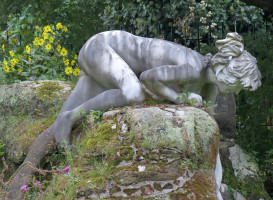
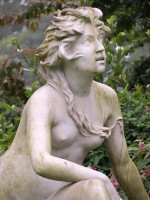
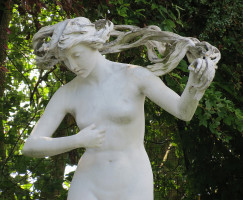
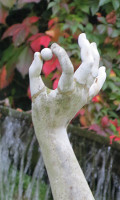
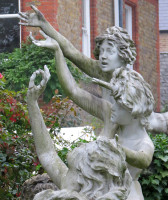
Among the explorable paths and green spaces in Twickenham, south-west London is the garden of York House, now a municipal park, and within it is a remarkable sculptural tableau within a rock garden. It consists of a series of nude girlish figures, made in white Carrara marble, in lively and unconventional poses. Clearly from the end of the 19th Century, they are evidently not English in origin, and it comes as no surprise to find they are Italian. The information provided by the Council, on a board next to the group, is that they represent Oceanides, Greek water nymphs which were associated more with fresh water than with the oceans, indubitably a right and proper subject for garden sculpture near water.
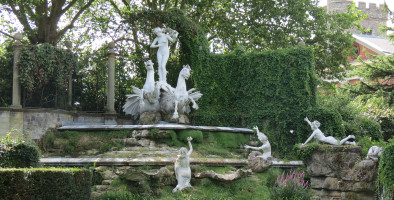 York House Gardens statues, overall composition (not all figures in view).
York House Gardens statues, overall composition (not all figures in view).
They were brought to England for an underhand financier called Whitaker Wright, and were brought to York House in 1909 by its then owner, Sir Ratan Tata, the Indian industrialist and philanthropist (whose family remains famous in the eponymous Tata Industries companies). There were other statues in similar style in the Whitaker Wright collection, and one of these bears the inscription O Spalmach, studio O Andreoni, Roma, and the Twickenham statues have generally been attributed on this basis. Orazio Andreoni was a sculptor in Rome in the late 19th Century, and a number of other sculptors, including the Venetian Oscar Spalmach (1864-1917) worked in his atelier. Barbara Spalmach, a great-granddaughter of the artist, has been able to confirm Oscar Spalmach was the sculptor, and has kindly provided photographs of two of the statues in their original state and the watercolour showing the whole group. Anyway, here they now are in Twickenham, in extremely good condition having been repaired with the replacement of lost fingers and toes by a modern sculptor, Keith Taylor, in the 1980s, and some further restoration in 2007.
Summit figure and hippogriffs.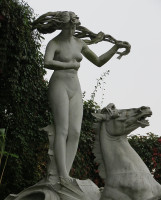
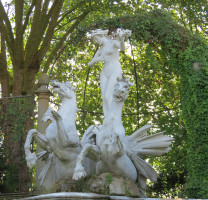
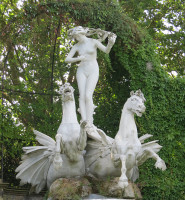
There are eight girls in all, with the summit figure accompanied by two hippogriffs, or water horses. We start with her. Suggested not particularly convincingly as a representation of Venus, a la Botticelli, she stands on what seems to be the prow of a boat or chariot being pulled by the hippogriffs. She is young, slender, with some slight indication of the muscular contours of torso and limbs, but overall an idealised figure of purity and almost over-sweetness. One hand is empty apparently some accoutrements were lost over the years, including pearls, the other hand holds long strands of her outstretched, art nouveau hair, which swirls in the wind. The hippogriffs are splendid creatures, one twisting its long sinuous neck upwards, the other with head turned down, spiky fins like small wings out to the sides, smaller fins on their hoofs. The placing of the sculptures means that we are rather limited in our viewpoint, but we can at least glimpse one long muscular tail lashing out behind.
Seated and falling girls.
Next, a girl seated on a rock, one leg down, the other forward and raised, so that she can rest an arm above the knee, her other arm outstretched to support her forward slanting body. Again, much attention has been given to her long hair, which drifts forward across her breasts, while her body and limbs are almost featurelessly smooth.
The third figure, as displayed, is falling forward from her seated position towards the pool beneath. The original positions intended for the sculpture are not known, and it may be that this girl was meant to be mounted in a different position. As it is, we cannot see her face, and the focus is on the extreme twist of her body, and the outstretched arms and legs. Unlike the case for the other figures, her hair is less highly carved, and is tiled into a small bun at the back.
Next, another girl whose face we cannot see; mounted almost centrally to the composition and thus in front and below the summit group. She kneels upright, one hand raised up, the other unseen in front of her. Unlike the other figures, who are entirely nude, there appears to be some ill-defined drapery around her legs and to the side.
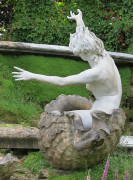
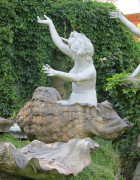 two views of the seashell girl.
two views of the seashell girl.
The next girl is seated within a large upturned seashell, made in a darker beige stone or marble which contrasts with the pure white figure emerging. Once again with arms outstretched, we can see her back and side, and a glimpse of her profile. What we can see of her body shows much more modelling than on the other figures.
Figure lying on front (contemporary picture courtesy of Barbara Spalmach).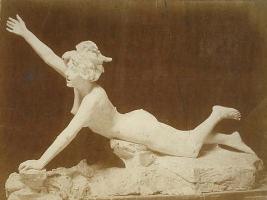
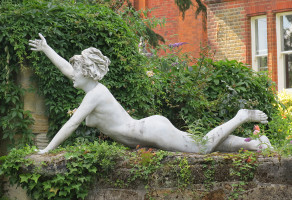
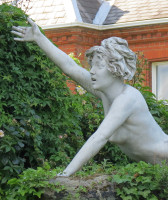
Our next figure, compositionally one of the most satisfying of the set, lies on her front, her upper torso raised up, one arm forward and supporting her, the other outstretched it is the line along this arm, down her back, flank and thigh, that make the figure so harmonious. This figure is again among the more highly modelled ones.
Finally, girls no. 7 and 8 form a linked group, the one crouched down, her arm stretched downwards, clasping the arm of her companion to draw her upwards. The two of them are looking towards each other, making a rather intimate group. The upper figure, as we see her, has the emphasis on her curled-up posture, while the lower is more stretched out, though she has one knee bent to provide support. The upper figure has her long hair heaped up on the head otherwise the face would have been obscured the hair of the lower figure swirls downward, a few wisps falling to waist length.
As the figures were originally planned, compared to today.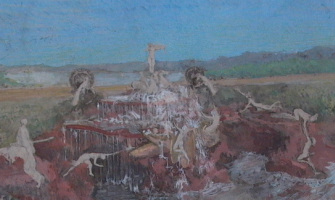
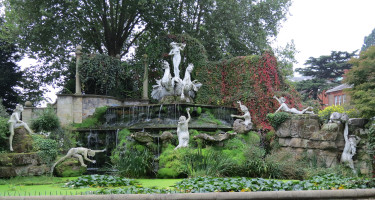
The assemblage as presented is carefully arranged, and very close in positioning to the original plan, as shown by the aquarelle kindly provided by Catherine Spalmach. We see the grouping to the right identical to the original plan, also the upper chariot group, and the figure beneath differs only in that her legs are stretched out in the aquarelle. We see the girl in the shell, and she who is falling, towards the left; only the figure furthest left, seems to be much different in pose, and perhaps if the existing figure were turned away from us, she would look not dissimilar to the view as once conceived. These figures were designed to be seen from all round, rather than from one view only, and it is a shame that the need to protect from vandalism has meant that we can only enjoy the one view. Regardless, the York House sculptures present a rather excellent opportunity to see rather unusually posed late 19th Century Italian figure sculpture in London.
This page was originally part of a 'sculpture of the month' series, for Oct 2103. Although the older pages in that series have been absorbed within the site, if you would wish to follow the original monthly series, then jump to the next month (Nov 2013) or the previous month (Sept 2013). To continue, go to the bottom of each page where a paragraph like this one allows you to continue to follow the monthly links.
Twickenham Church monuments // Twickenham War Memorial, Radnor Gardens // London sculpture // Sculptors
Visits to this page from 1 Oct 2013: 1,747 since 9 September 2024